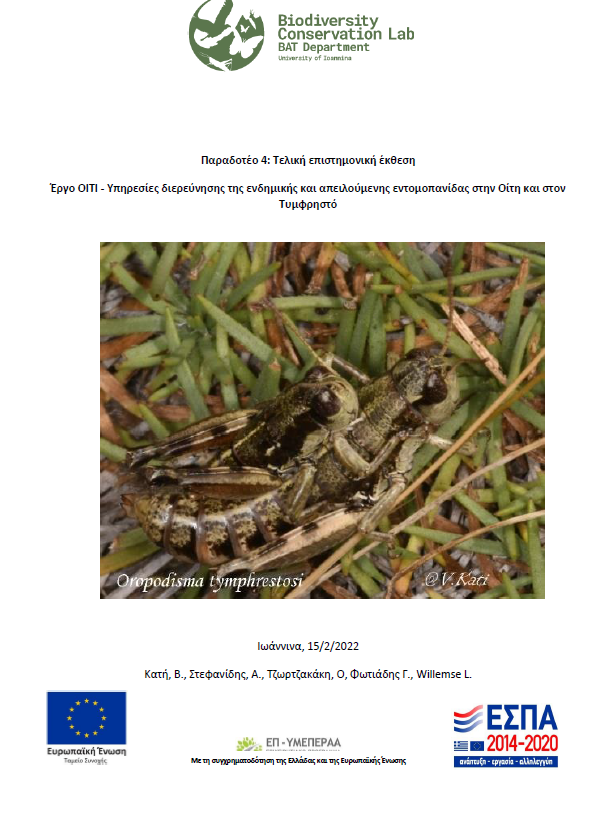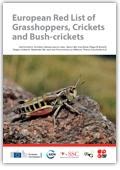Kati V., Petridou M., Theodoropoulos Y., Bukas N. 2019. Contribution to biodiversity knowledge of the Aoos River Basin / Greece. Pindos Perivallontiki, 65pp
The Vjosa/Aoos river still flows freely from the Pindus mountains in Greece, to the river mouth in Albania largely without artificial obstacles. The river stretches for 270km in total and 70km are flowing within the Greek area. Downstream of the Pigai dam in Greece (10km from the springs of Aoos), the river is near natural, representing all types of river ecosystems, including canyon sections, braided parts and meandering stretches. In Greece the protected area, that partly includes river Aoos, belongs to the Northern Pindos National Park. The existing National Park is already protecting 50kms of Aoos’ river stretch, leaving nearly 20km of the river unprotected, towards the GR-AL borders (see Map 1). At the same time one of the major tributaries, Voidomatis (15km long) is included in the existing National Park, leaving 6km of the tributary unprotected, towards the GR-AL borders. Another major tributary, river Sarantaporos (50km long), stretches under no protection zone, from its springs until its confluence with Aoos, right upon the GR-AL borders. Voidomatis and Sarandaporos rivers are the main tributaries of Aoos. Voidomatis meets up with Aoos in the plain of Konitsa, and Sarandaporos joins them right on the Greek-Albanian border. Through this year’s biodiversity research, we aim to increase the biodiversity knowledge for the unprotected area of the Aoos river basin, in order to further support the efforts of the campaign for the expansion of the Aoos’ protected area towards the GR-AL borders, in a way that will include the unprotected stretches of Aoos and its major tributaries (Voidomatis, Sarantaporos). The present study is focusing on insect species related to water (Odonata), as well as on large mammals, either directly related to the riverine ecosystems (otter) or indirectly (carnivores and ungulates). The present biodiversity research sets four distinct objectives: • To provide a georeferenced database of species distribution in the study area, with special focus on the part of the area that is under no protection status. • To assess different microhabitats of Aoos’ catchment in terms of their ecological value for the target species. • To assess potential pressures and threats for the species. • To crystalize research findings into concrete conservation objectives.
Petridou M., Iliopoulos Y., Kati V. 2019. Wolf-livestock conflict in Tzoumerka National Park and comparisons with other protected areas of Greece. University of Ioannina and WWF Greece. Ioannina, Greece, pp. 51.
Livestock depredation is one of the main wolf-human conflict issues both in Europe and worldwide. The aim of the project is to study and evaluate wolf-livestock conflicts in Tzoumerka NP and to compare our findings with other protected areas in Greece. We have in particular set the following six research objectives: 1. To assess and describe traditional free-ranging livestock raisers’ profile in Tzoumerka NP. 2. To record wolf depredation levels on cattle, sheep and goat herds as the main baseline metric of wolf-human conflicts in Tzoumerka NP. 3. To identify and evaluate the principal damage prevention methods adopted by local livestock farmers in Tzoumerka NP. 4. To assess levels of livestock guarding dog mortality due to the illegal use of poisoned baits as a major conservation problem in the area in Tzoumerka NP. 5. To evaluate satisfaction levels of livestock farmers regarding the national compensation system in Tzoumerka NP. 6. To compare the main results stemming from Tzoumerka NP with other similar studies previously completed in other protected areas and draw relevant conclusions. © 2019 University of Ioannina and WWF Greece
Kati, V., Stefanidis, A., Tzortzakaki, O., Fotiadis, G., Willemse, L. 2022. Final Scientific Report: Project OITI-Investigating the endemic and threatened entomofauna in Oiti and Tymfristos. 56 p.
The current technical report presents the results of a research project in two Natura 2000 sites, namely the National Park of Oeta Mountain (GR2440004) and Tymphristos mountain (GR2430001). OITI project concerned the Orthoptera community of the two mountains and specifically their endemic and/or threatened species. It presents the objectives of the study, the methods and protocols used during fieldwork, and the research findings as follows: overview of the threats and pressures recorded in the study area, inventory of the recorded orthoptera fauna in the two protected areas, a thorough ecological overview of target species, presenting their conservation status (distribution, population status, habitat preferences , pressures and threats). The study suggests the inclusion of 11 important orthoptera species in the Standard Data Forms (SDFs) of the Natura 2000 sites, evaluates the ecological importance of the study area in terms of Orthoptera fauna conservation, and provides an evaluation of the pressures/threats that need to be addressed. It concludes to a conservation guideline relevant to (a) providing permissions for projects that cause land use change on target species habitats, such as renewable or tourist infrastructure, (b) livestock grazing management, (c) biomonitoring of target species, (d) Natura 2000 area expansion.




